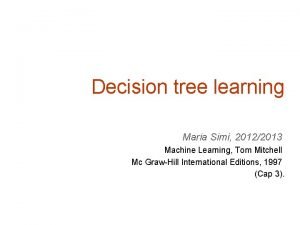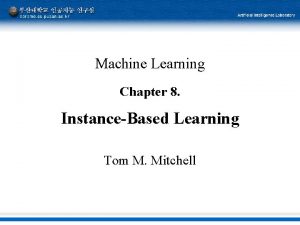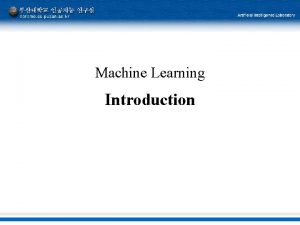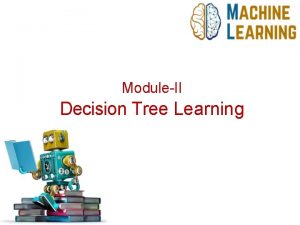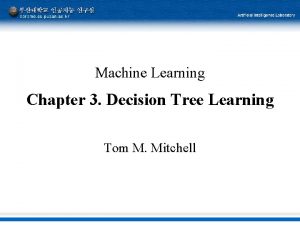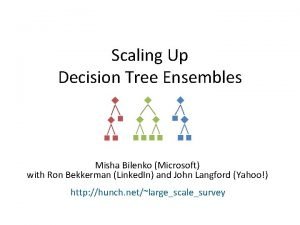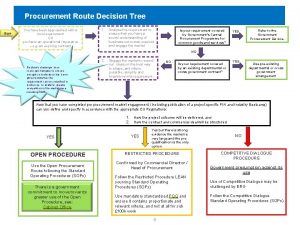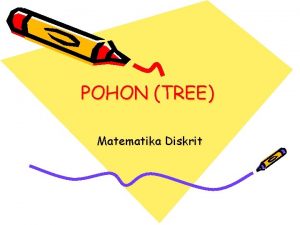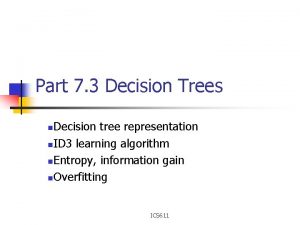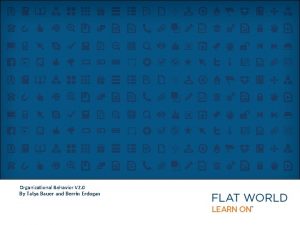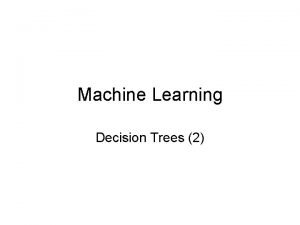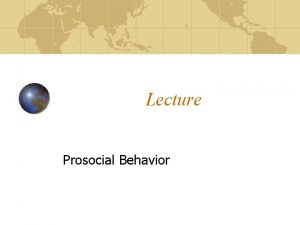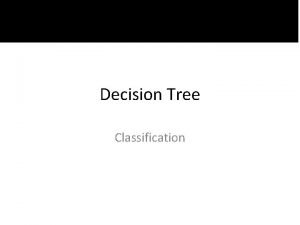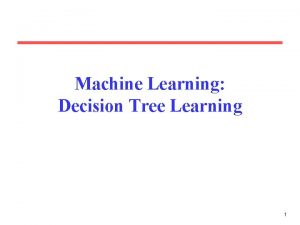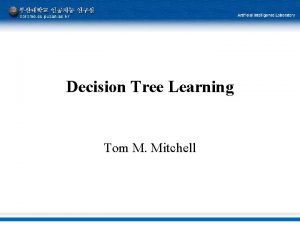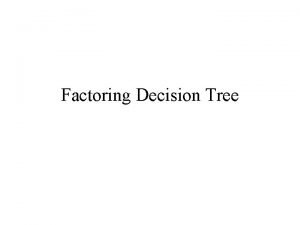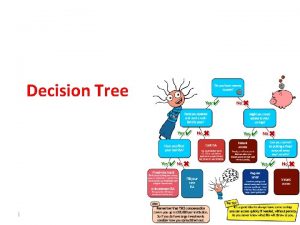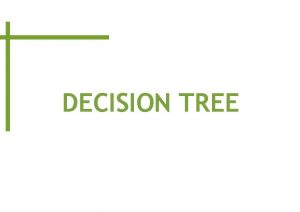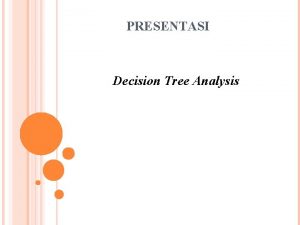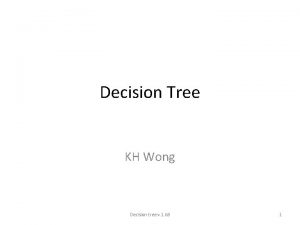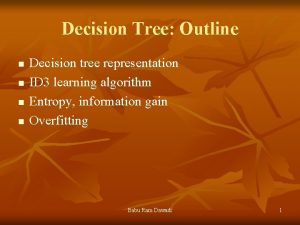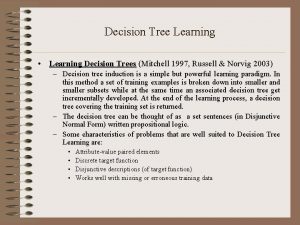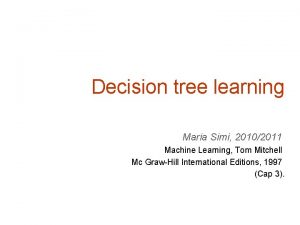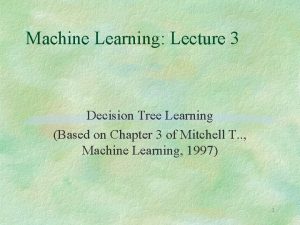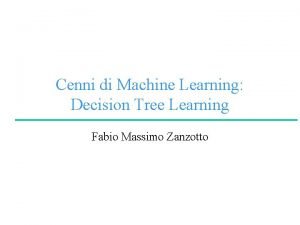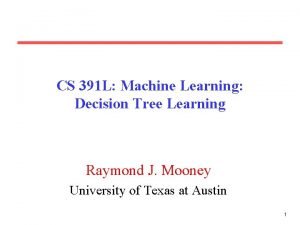Machine Learning Chapter 3 Decision Tree Learning Tom





























- Slides: 29

Machine Learning Chapter 3. Decision Tree Learning Tom M. Mitchell

Abstract § § Decision tree representation ID 3 learning algorithm Entropy, Information gain Overfitting 2

Decision Tree for Play. Tennis 3

A Tree to Predict C-Section Risk § Learned from medical records of 1000 women § Negative examples are C-sections 4

Decision Trees § Decision tree representation: – Each internal node tests an attribute – Each branch corresponds to attribute value – Each leaf node assigns a classification § How would we represent: – , , XOR – (A B) (C D E) – M of N 5

When to Consider Decision Trees § § Instances describable by attribute-value pairs Target function is discrete valued Disjunctive hypothesis may be required Possibly noisy training data Examples: § Equipment or medical diagnosis § Credit risk analysis § Modeling calendar scheduling preferences 6

Top-Down Induction of Decision Trees § Main loop: 1. A the “best” decision attribute for next node 2. Assign A as decision attribute for node 3. For each value of A, create new descendant of node 4. Sort training examples to leaf nodes 5. If training examples perfectly classified, Then STOP, Else iterate over new leaf nodes § Which attribute is best? 7

Entropy(1/2) § § S is a sample of training examples p⊕ is the proportion of positive examples in S p⊖ is the proportion of negative examples in S Entropy measures the impurity of S Entropy(S) - p⊕log 2 p⊕ - p⊖log 2 p⊖ 8

Entropy(2/2) Entropy(S) = expected number of bits needed to encode class (⊕ or ⊖) of randomly drawn member of S (under the optimal, shortest-length code) Why? Information theory: optimal length code assigns – log 2 p bits to message having probability p. So, expected number of bits to encode ⊕ or ⊖ of random member of S: p⊕(-log 2 p⊕) + p⊖(-log 2 p⊖) Entropy(S) - p⊕log 2 p⊕ - p⊖log 2 p⊖ 9

Information Gain(S, A) = expected reduction in entropy due to sorting on A 10

Training Examples 11

Selecting the Next Attribute(1/2) Which attribute is the best classifier? 12

Selecting the Next Attribute(2/2) Ssunny = {D 1, D 2, D 8, D 9, D 11} Gain (Ssunny , Humidity) =. 970 - (3/5) 0. 0 - (2/5) 0. 0 =. 970 Gain (Ssunny , Temperature) =. 970 - (2/5) 0. 0 - (2/5) 1. 0 - (1/5) 0. 0 =. 570 Gain (Ssunny, Wind) =. 970 - (2/5) 1. 0 - (3/5). 918 =. 019 13

Hypothesis Space Search by ID 3(1/2) 14

Hypothesis Space Search by ID 3(2/2) § Hypothesis space is complete! – Target function surely in there. . . § Outputs a single hypothesis (which one? ) – Can’t play 20 questions. . . § No back tracking – Local minima. . . § Statistically-based search choices – Robust to noisy data. . . § Inductive bias: approx “prefer shortest tree” 15

Inductive Bias in ID 3 Note H is the power set of instances X → Unbiased? Not really. . . § Preference for short trees, and for those with high information gain attributes near the root § Bias is a preference for some hypotheses, rather than a restriction of hypothesis space H § Occam's razor: prefer the shortest hypothesis that fits the data 16

Occam’s Razor Why prefer short hypotheses? Argument in favor : § Fewer short hyps. than long hyps. → a short hyp that fits data unlikely to be coincidence → a long hyp that fits data might be coincidence Argument opposed : § There are many ways to define small sets of hyps § e. g. , all trees with a prime number of nodes that use attributes beginning with “Z” § What's so special about small sets based on size of hypothesis? ? 17

Overfitting in Decision Trees Consider adding noisy training example #15: Sunny, Hot, Normal, Strong, Play. Tennis = No What effect on earlier tree? 18

Overfitting Consider error of hypothesis h over § training data: errortrain(h) § entire distribution D of data: error. D(h) Hypothesis h ∈ H overfits training data if there is an alternative hypothesis h'∈ H such that errortrain(h) < errortrain(h') and error. D(h) > error. D(h') 19

Overfitting in Decision Tree Learning 20

Avoiding Overfitting How can we avoid overfitting? § stop growing when data split not statistically significant § grow full tree, then post-prune How to select “best” tree : § Measure performance over training data § Measure performance over separate validation data set § MDL: minimize size(tree) + size(misclassifications(tree)) 21

Reduced-Error Pruning Split data into training and validation set Do until further pruning is harmful: 1. Evaluate impact on validation set of pruning each possible node (plus those below it) 2. Greedily remove the one that most improves validation set accuracy § produces smallest version of most accurate subtree § What if data is limited? 22

Effect of Reduced-Error Pruning 23

Rule Post-Pruning 1. Convert tree to equivalent set of rules 2. Prune each rule independently of others 3. Sort final rules into desired sequence for use Perhaps most frequently used method (e. g. , C 4. 5 ) 24

Converting A Tree to Rules IF THEN …. (Outlook = Sunny) ∧ (Humidity = High) Play. Tennis = No (Outlook = Sunny) ∧ (Humidity = Normal) Play. Tennis = Yes 25

Continuous Valued Attributes Create a discrete attribute to test continuous § Temperature = 82. 5 § (Temperature > 72. 3) = t, f 26

Attributes with Many Values Problem: § If attribute has many values, Gain will select it § Imagine using Date = Jun_3_1996 as attribute § One approach : use Gain. Ratio instead where Si is subset of S for which A has value vi 27

Attributes with Costs Consider § medical diagnosis, Blood. Test has cost $150 § robotics, Width_from_1 ft has cost 23 sec. How to learn a consistent tree with low expected cost? One approach: replace gain by § Tan and Schlimmer (1990) § Nunez (1988) where w ∈ [0, 1] determines importance of cost 28

Unknown Attribute Values What if some examples missing values of A? Use training example anyway, sort through tree § If node n tests A, assign most common value of A among other examples sorted to node n § assign most common value of A among other examples with same target value § assign probability pi to each possible value vi of A – assign fraction pi of example to each descendant in tree Classify new examples in same fashion 29
 Inductive bias in decision tree learning
Inductive bias in decision tree learning Objectives of decision making
Objectives of decision making Investment decision financing decision dividend decision
Investment decision financing decision dividend decision Tom mitchell machine learning solutions chapter 3
Tom mitchell machine learning solutions chapter 3 Decision tree and decision table examples
Decision tree and decision table examples Machine learning tom mitchell
Machine learning tom mitchell Reduced error pruning example
Reduced error pruning example Inductive bias in decision tree learning
Inductive bias in decision tree learning Go 910
Go 910 The devil and tom walker symbols
The devil and tom walker symbols Concept learning task in machine learning
Concept learning task in machine learning Analytical learning in machine learning
Analytical learning in machine learning Pac learning model in machine learning
Pac learning model in machine learning Machine learning t mitchell
Machine learning t mitchell Inductive and analytical learning
Inductive and analytical learning Combining inductive and analytical learning
Combining inductive and analytical learning Instance based learning in machine learning
Instance based learning in machine learning Inductive learning machine learning
Inductive learning machine learning First order rule learning in machine learning
First order rule learning in machine learning Eager classification versus lazy classification
Eager classification versus lazy classification Cmu machine learning
Cmu machine learning Miemss trauma decision tree
Miemss trauma decision tree Misha bilenko
Misha bilenko Procurement decision tree
Procurement decision tree Matematika diskrit pohon
Matematika diskrit pohon Xor decision tree
Xor decision tree Vroom's decision tree approach
Vroom's decision tree approach Networking and internetworking devices
Networking and internetworking devices Andrew ng decision tree
Andrew ng decision tree Latane and darley decision tree
Latane and darley decision tree
